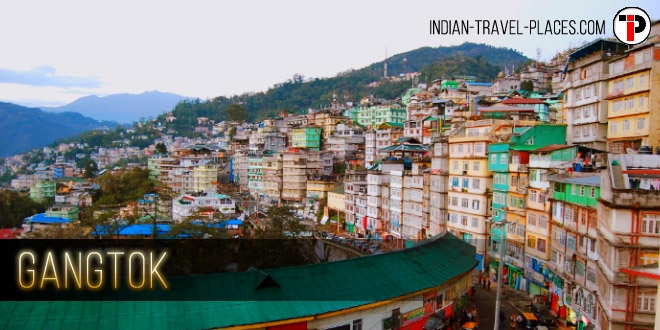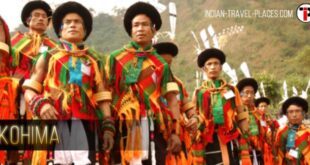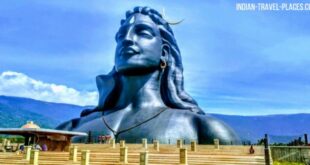Gangtok is the capital of the mountainous northern Indian state of Sikkim. Established as a Buddhist pilgrimage site in the 1840s, the city became capital of an independent monarchy after British rule ended, but joined India in 1975. Today, it remains a Tibetan Buddhist center and a base for hikers organizing permits and transport for treks through Sikkim’s Himalayan mountain ranges.
| Name: | Gangtok – Capital city of Sikkim |
| Location: | East Sikkim District, Sikkim |
| Climate: | Summers: 25° C (Max), 14° C (Min) | Winters: 16° C (Max), -1° C (Min) |
| Best Time To Visit: | September to May |
| Nearest Airport: | Bagdogra Airport |
| Railway Station: | New Jalpaiguri |
| Must Visits: | Rumtek Monastery, Tsongo Lake, Nathu-La Pass, Namgayal Institute of Tibetology, Enchey Monastery |
| Language Spoken: | Hindi, English, Bhutia (Sikkimese), Tibetan and Lepcha |
| STD Code: | 03592 |
Gangtok is the proud capital of Eastern Indian state of Sikkim. This twinkling town is nestled amidst the Shivalik hills and in the foothills of Majestic Himalayas. It is spread over an area of 25 square kilometers and is the largest town of the state, Sikkim. Sited at an elevation of 1,700 m above the average sea level, this city features a monsoon-influenced subtropical highland climate with pleasant summers, breezy cold winters and heavy monsoons with average annual rainfall of 3894 mm. Though, Gangtok is a round-the-year destination, the best time to explore the natural beauty of this town is from the month of September (after monsoons) to May. Perched on the ridge of a hill, this city is renowned for its picturesque natural beauty and pictorial views of glorious Mt. Kanchenjunga, the third highest mountain peak in the world.
To be close to nature and its bliss, thousands of domestic as well as foreigner tourists visit this city yearly. In fact, tourism is a prominent industry for economy of Gangtok. There is not much evidence of Gangtok’s early history, but this town rose as a major Buddhist pilgrimage centre after the establishment of Enchey Monastery in the year 1840. Later, in 1894 Thutob Namgyal (ruling king of Sikkimese Chogyal Monarchy) made it his capital. After few years, this city evolved as major stop over on the trade route between Lhasa in Tibet and eastern cities during British Raj. When India got independence from British, Sikkim chose to remain an independent monarchy. It was only in the year 1975, when Union of India took place that Gangtok was declared as the twenty second state capital.
The meaning of Gangtok is not clear but according to the locals, the popular meaning of it is “Hill Top”. Gangtok is touched by River Roro Chu in the east and River Ranikhola in the west. Apart from being a major tourist destination, this city is an eminent centre of Tibetan Buddhist culture and learning for being home for several monasteries, religious educational institutions, and centres for Tibetology. Some of the tourist spots that one should never miss to explore are Rumtek Monastery, Tsongo Lake, Nathu-La Pass, Namgayal Institute of Tibetology, Enchey Monastery, Do-Drul Chorten (stupa), Jawaharlal Nehru Botanical Garden, Tashi View Point, Ganesh Tok and Hanuman Tok. If you love to shop, the M.G. Road present in the main street of Gangtok is a shopper’s paradise offering authentic handicrafts and artifacts.
Best Time To Visit Gangtok
As you journey through the winding roads towards Gangtok, the path ahead of you seems to be covered with cotton fleeces. This is because of the dewdrops that cover the roads on a chilly day. The trek up the hill is a complete delight to your senses. If you have seen the travel catalogues on Gangtok, you would know that they all promise you a spectacular view of the Kanchenjunga. One of the highest peaks in the world, a view of the Kanchenjunga range is truly a treat for the eyes. For many of us, Gangtok may seem like a remote little village perched on a hilltop, but in reality, the town hosts many exciting events. From trekking and river rafting to flower exhibitions and peaceful monasteries, Gangtok does have a string of things to flaunt. Gangtok is a charming little town with friendly people who have an adventurous streak in them. With a climate that is pleasant all throughout the year, Gangtok beckons travelers from far and near. Explore the following sections to know about the best time to visit the picturesque hill station of Gangtok.
When To Go To Gangtok
Weather Conditions:
The weather condition in Gangtok is similar to the sub-tropical highland areas. Summer in Gangtok commences from April and lasts until the first few week of June. The temperature during this season usually goes up to 25° C and dips down to a minimum of 16° C. Winter temperature in this Himalayan hill station can range anywhere between a chilling 07° C to 04° C. Although some places close to Gangtok experiences snowfall, Gangtok rarely sees any snowfall. Winter sets in during the last week of December and lasts until February. Monsoon in the town is extremely severe and sometimes can trigger landslides, thus, blocking the roads and the highways. June to September sees severe rainfall in the region.
Travel During The Right Season:
During the summer season, the hills come alive with the colorful blooms and the clear, blue skies look stunning. Summer begins in the month of March and last until the early days of May. This is the best time to try out water sports like river rafting, which is very popular among the tourists here. Winters, on the other hand, are extremely cold with occasional snowstorm adding to the winter chill. Autumn in Gangtok starts from October and lasts until November. The pleasant weather during autumn makes it the perfect time for an action-packed day outdoors. Pre-monsoon season begin towards the end of May. During June to September, Gangtok receives heavy rainfall and landslides that disrupts the communication in this region.
Best Time To Visit:
The best time to visit Gangtok would be anytime between March to May. The weather during these summers months are absolute delightful with cool mountain breeze and the amazing view of snowy Kanchenjunga transforming from blushing pink to fiery golden orange, good enough to woo your senses. Another reason to visit Gangtok during summer is to witness its brilliant flower show, which is one of the major attractions of this hill station. The flower exhibition, which lasts from the month of March to June, hosts the best of the local flora and fauna available in the region like the multihued orchids, bonsai, sunflowers, marigolds, poinsettias and other beautiful seasonal flowers. If you happen to be in Gangtok during this time, make sure to attend this flower show.
History Of Gangtok
Unlike many cities in the sub-continent, Gangtok remained as an unknown hamlet. According to the epigraphists, not much is known about the early history of Gangtok. The region has never been subservient to any monarchial rule due to which the region remained unnoticed for several decades. The city became popular only in the year 1840 with the construction of a Buddhist monastery. With the establishment of ‘Enchey Monastery’ in Gangtok, the place became an important Buddhist learning centre, which followed the order of Vajrayana Buddhism in the region. On the economic front, the city still remained underdeveloped and did not see much progress. It was only after the British Indian-Tibet war that the place was noticed as a potential flourishing trade route in the region. After the war, the mountain passes were opened up for trading activity with the neighboring regions. The state of Sikkim remained autonomous for a short while. Read on to know more about the history of Gangtok in the following sections.
Gangtok History
Early Period
Although the city’s early history remains unknown and vague, the place earned its name as a popular Buddhist learning centre in India. The oldest citation of Gangtok can be traced back to the year 1716 with the construction of a small monastery. During that period, the province served as a rural community of Buddhist monks. After the establishment of the Enchey Monastery in 1840, the place became an important religious centre. Legend states that a sage by the name Padmasambhava, who spread the teachings of Vajrayana Buddhism in Bhutan and Tibet, suppressed the powers of protecting deities like Khangchendzonga, Yabdean and Mahakala, present in the monastery.
British India:
The state of Sikkim allied with the British in order to fight off invaders from Nepal. This involved the intervention of English officials in the region. It was in the 19th century that the British understood its military and trading prospective in the region. By the early 1900s, colonial India wanted to establish its bilateral relationship with Tibet. During 1903 and 1904, Tibet was invaded by the British on the pretext of preventing the Russian Empire from capturing the region. The British officials had set up a military garrison in one of the districts of Tibet. Gangtok during this time became a regular halting point among merchants travelling between Tibet and Colonial India. During this period, Gangtok was a flourishing town. Apart from the growth in trade, the town’s infrastructure and communication sectors also grew. By the end of the nineteenth century, the city saw constructions of roads and buildings and the installation of a telegraph centre. Thutob Namgyal, who was the reigning ‘chogyal’ (emperor) during that period, shifted his capital in the year 1894, to Gangtok. This, in turn, raised the significance of Gangtok. The king of Sikkim then ordered the construction of a palace and other state buildings in Gangtok.
Post- Independence:
After India’s independence in 1947, the state of Sikkim including the territory of Gangtok was considered to be a ‘geo-political entity’ commonly known as a ‘nation state’. Pandit Jawaharlal Nehru signed a treaty with the royal chogyal monarchs in the region stating that the place would remain suzerain to India if Sikkim was allowed to maintain its independency. The ‘Nathula’ and ‘Jelepla’ passes located near Gangtok were responsible for the growth of the silk trade in the region. The path leading to these two passes was called as the ’silk route’ and connected to several countries in Europe, North Africa and West Asia. In 1962, when the Sino-Indian war took place, the trading mountain passes where closed until 2006, due to the rising hostility present in the area. By 1975, the monarchy of Sikkim was withdrawn and Sikkim became an Indian state with Gangtok as its capital.
How To Reach Gangtok
Tucked away in the Himalayan Mountains, far from the hustle and bustle of urban India, Gangtok is a popular hill station in the state of Sikkim. Erstwhile, an important Buddhist pilgrimage today, this town serves as an important tourist destination. This picturesque hill station comprises of serene vistas, learning institutions on Tibetology and other cultural centers of Tibet Buddhism. Apart from this, Gangtok has an interesting mix of spirituality and ecotourism. From challenging trekking opportunities to mouth-watering eateries and from shopping centers to a wild night out at discotheques, there are quite a lot of things to do in the town of Gangtok. Although the town does not boast of a great infrastructure, a visit to Gangtok is worth all the fatigue you are about to experience and you couldn’t agree more once you are in Gangtok. Scroll through the following sections to know how to reach Gangtok and the best transport options available.
Traveling To Gangtok
By Air:
If you prefer to travel by air, then the closest airport is the Bagdogra airport located in West Bengal. The distance between Gangtok and Bagdogra airport is about 124 km. The airport is well connected to the cities of Kolkata, Patna, Delhi, Imphal and Guwahati. There are regular buses and taxis that ply between Gangtok and Bagdogra. However, make sure to leave a little early just to be in time for your check-in at the airport.
By Helicopter:
Besides travelling by domestic air flights, you can also use helicopter services provided by the local tourism board. To avail the use of this service, you would have to contact your local travel agent much in advance to confirm the bookings. This service is restricted to only one time in a day and allows only four passengers at a time. The helicopter ride from Bagdogra to Gangtok is a short 20 minutes journey.
By Rail:
This hill station does not have a railway junction. People travelling by train use the nearest railway station located at Siliguri and New Jalpaiguri. Siliguri is positioned 114 km away from Gangtok, while New Jalpaiguri is 126 km from the city. There is no need for concern on how to reach the place, as there are several taxis, buses and coaches to take you to the hill station.
By Road:
Gangtok has reasonably good roads and is well-connected to its neighboring towns of Siliguri, Darjeeling and Kalimpong. You can take the NH 31A as this is the best route to reach Gangtok. If you are a first time traveler, do keep in mind the weather as it can get quite foggy. It is therefore best to avoid traveling during evening or night.
Entry Regulations:
Sikkim lies close to the borders of Nepal on the west Tibet and controlled by the Republic China in the north east and Bhutan on the east. Due to this, foreigners are required to obtain the ‘Inner Line of Permit’ (ILP) along with their Indian visa. The ILP can be acquired from respective Indian Embassies situated abroad. You can also contact the ‘Sikkim Tourism Board Bureau’, which is located in Siliguri, Delhi and Kolkata to obtain the permit. If you are an Indian national travelling to this place, do make sure to carry your identification documents for verification purposes.
Places To Visit In Gangtok
Scenic beauty, colorful orchids and glorious monuments make Gangtok a fairyland attraction for the tourists. Being a land of diverse culture and religions, the city welcomes people from all walks of life. The city is dotted with beautiful monasteries and other architectural wonders. Some of these monasteries delight you with their interesting stories and beautiful artistry. With its natural and cultural bounties, Gangtok is truly an ultimate holiday destination that promises a relaxing, laid back and enthralling holiday experience to the vacationists. Just like its magical appeal, the city is admired for its regional specialties that are sold like hot cakes in most of the shops. From handicrafts to handlooms to jewelry and lots more, the city has its own unique touch, which captivates the attention of every visitor. To explore the real essence of this city, its best to plan a visit to Gangtok. Trail down the write-up below to explore the tourist attractions in Gangtok.
Tourist Attractions In Gangtok
Deer Park:
Deer Park, an important landmark in Gangtok, serves as an important attraction for the tourists. Also known as the ‘Rustomji Park’, this park is situated adjacent to the new secretariat building. As the name suggests, the park enclosure houses a large number of deer of different species. The beautiful statue of Lord Buddha within the premises gives the visitors a glimpse into his noble teachings. Adding to the exotic beauty of the statue is a butter lamp that burns continuously.
White Hall:
The famous White Hall of Gangtok was built in the year 1932 in memory of Claude White, the first political officer of Sikkim. This place is admired even today for its historical value and beautiful architecture.
Himalayan Zoological Park:
The ‘Himalayan Zoological Park’, situated near Ganesh Tok temple, is spread over an area of 205 hectares of land. If you want to explore the delights of nature, then there is no better place than this. So don’t forget to visit the Himalayan Zoological Park on your trip to Gangtok. This park is the abode to a great variety of wild species including barking deer, civet cats, black deer, snow leopards, red pandas and spotted deer. Although jeeps are allowed for the first 3 km, you will need to walk through the roads to get the sight of animals further down.
Orchid Sanctuary:
The ‘Orchid Sanctuary’ is a must-visit site in Gangtok. Famous for its rare and extensive collection of orchids from around the world, this flower sanctuary hosts nearly 454 species of orchids and is the ultimate place for nature lovers. You can enjoy the beauty of this place from Monday to Friday between 10 am to 4 pm.
Government Institute Of Cottage Industries:
Situated near the main market area of Gangtok, the ‘Government Institute of Cottage Industries’, established during the reign of the Chogyals displays the major attractions of the region like authentic Sikkim handicrafts and arts made by local village artisans. Some of the specialties of the Sikkim, namely Thankas, Choksees, shades, carved tables, lamp-stands and other crafts are sold like hot cakes over here. Closed on all Sunday, second Saturdays and on all government holidays, the place remains open on all other days.
Ganesh Tok:
Ganesh Tok is a small temple dedicated to Lord Ganesh and is admired for its mystical powers. Situated on a small hill on the Gangtok-Nathula Road, the area provides a spectacular view of the Gangtok city, Raj Bhawan complex and Mt. Khangchendzonga. Adding to this refreshing splendor is a small garden of beautiful pine trees.
Shopping In Gangtok
The hilly town of Gangtok, posited on the Shivalik Hills, with its pointy peaks, inspiring views and warm culture truly poses as an amazing getaway destination for the vacationists. Cuddled against the Himalayas, the fascinating city of Gangtok is the best place to experience a laidback vacation trip. The beautiful terrain, the smiling faces of the local people and their religious practices lend a mystic aura to the town. The town is dotted with a number of markets and shops that are known for embellished items such as handicrafts and artifacts that display the talent of local artisans and artisans. Apart from that you can also shop for Lepcha weave bags, bamboo artifacts and other amazing local handicrafts. From tiny hangings to huge handicrafts and from stunning carpets to exotic jewelry the city serves all your needs. To know more about vibrant shopping spots in Gangtok, explore the sections below.
Shopping Places In Gangtok
What To Shop:
Popular for its diverse culture, Gangtok is admired for colorful shopping destinations, which will delight you with its spectacular attractions. Among the list of specialties, canvas and wall hangings are ones that are known for flawless use of colors and threads that display the historical and tribal background of people. The world famous Tibetan Carpets with stunning patterns reflect the art and culture of the state. The beautiful dragon sets with gold polish, silver and precious stones are known for their exquisitely carved designs. Some of the other must buy items of the city are Sikkim tea, alpine cheese, black cardamom, fresh bamboo shoots, glass beads, hand-woven jackets, semi-precious stones and silver jewelry. Apart from the mentioned items, there are plenty of other novelties and handicrafts that will surely mesmerize you by their fine art. To get a few important shopping places in this town, read on.
Directorate Of Handicrafts And Handloom Emporium:
The ‘Directorate of Handicrafts & Handloom Emporium’, the new name for the ‘Handloom and Handicrafts Centre’ of Sikkim attracts every person visiting Gangtok. Situated near the main market area of city, it was founded in 1957 by the Chogyals of Sikkim. Established with the intention of preserving and propagating the art and craft of local artisans, it displays traditional motifs, carpets and various other local handicrafts such as Thankas, Choksee, hand-carved wooden tables and furniture. The carpets that are produced here are highly admired for their fine textures and amazing designs that range from the most recent designs to very traditional ones. With no less than 500 workers engaged in crafts and art, the emporium produces the best quality products at very reasonable prices to favor the tourists and art lovers. Thus if are looking for a rich collection of items at throwaway prices then the Directorate is the place for you.
Shopping Areas:
To get the essence of exquisite items of the city, you can go through the lanes of noted market areas of Gangtok such as Old market, New market, Lall market and M.G. Road. These markets are good to roam around and shop in, as the bazaars and super markets are full of lovely items for you to buy or just admire. Presenting almost all the popular items of Sikkim, these places sell traditional as well as contemporary items that captivate the attention of every person visiting this place. Sikkim Tea, which is admired for its exotic taste and unique flavor, serves as the ideal gift to carry back home from Gangtok.
 ITP Indian Travel Places: Food, Travel, Tourism Business Events and Trade Shows
ITP Indian Travel Places: Food, Travel, Tourism Business Events and Trade Shows







